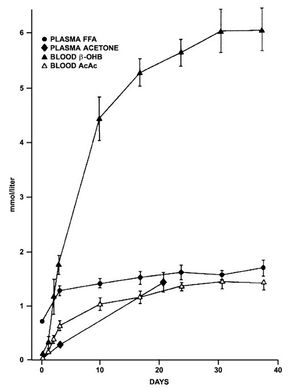Ketone Levels
Revision as of 12:40, 13 January 2014 by User:Fellrnr (User talk:Fellrnr | contribs)
Revision as of 12:40, 13 January 2014 by User:Fellrnr (User talk:Fellrnr | contribs)
There are three important Ketones involved in Ketogenic Diets, Acetoacetic acid (AcAc), Acetone, and Beta-hydroxybutyrate (BOHB). Their levels can vary somewhat independently, and the target levels for different results are not well defined. Blood levels of BOHB from 0.5 to around 3-5.0 mmol/L have been labeled 'nutritional ketosis' and levels over 4.0 mmol/L are probably best for treatment of Epilepsy.
Contents
1 Relative Levels

Changes in blood ketone levels during progressive starvation[1].
- As shown above, the ratio of AcAc to BOHB can change dramatically during progressive starvation, with BOHB rising far higher than AcAc[1]. Also, during diabetic ketoacidosis (DKA), the ratio of BOHB:AcAc rises from normal (1:1) to as high as 10:1[2].
- Urine ketone levels vary with the time of day, often being lower in the morning[3]
- The ratio between AcAc and Acetone appears reasonably constant, and is based on the spontaneous, one way decomposition of AcAc into Acetone[4].
2 Target Levels
There are no well-defined ketone levels at which particular changes occur. The list below is a sampling of the levels I've found used.
- The level required to be ketogenic (hyperketonemia) has been suggested as 0.2 mmol/L measured as the combination of AcAc and BOHB in whole blood as this is slightly above the levels seen in "normal" individuals[5].
- The book "The Art and Science of Low Carbohydrate Living" calls the range 0.5 to 5.0 mmol/L of blood ketones "nutritional ketosis"[6]
- The follow on book "The Art and Science of Low Carbohydrate Performance" suggests that BOHB levels of 0.5 mmol/L to 3.0 mmol/L is "optimal"[7], with benefits starting at 0.5 mmol/L and improving to 3.0 mmol/L, but levels above 3.0 mmol/L not producing additional benefits[8].
- For epilepsy, the recommendation is for AcAc to be 80-160 mmol/L as measured by urine dipstick[9], though this level is not necessarily sufficient[10].
- A study of 74 children on the ketogenic diet for epilepsy found that blood BOHB levels of greater than 4 mmol/L were correlated with better seizure control than those with lower levels[10].
3 Example levels
From "Physiological roles of ketone bodies as substrates and signals in mammalian tissues"[5]:
| Situation | Ketone Levels (Blood levels of AcAc + BOHB) |
|---|---|
| Fed | ~0.1 |
| Fasted 12-24 Hours | Up to 0.3 |
| Fasted 48-72 Hours | 2-3 |
| Fasted 5-6 weeks (plateau) | ~8 |
| Post exercise | Up to 2 |
| Late Pregnancy | Up to 1 |
| Late Pregnancy, fasted 48 hours | 4-6 |
| Neonatal | 0.5-1.0 |
| Hypoglycemia | 1-5 |
| Controlled diabetes | Up to 25 |
4 See Also
- The classifications and types of Low Carbohydrate Diet.
- An introduction to the Ketogenic Diet.
- My experiences with ultrarunning on the Ketogenic Diet
- How the Ketogenic Diet can be used for the treatment and management of disease.
- Health Risks of the Ketogenic Diet
- The time frame and changes that occur with Ketoadaptation
- What are Ketones
- How to measure Ketones
- What ketone levels to aim for
- The pros and cons of the Ketogenic Diet for athletes
- The Types of Ketogenic Diet
- My Ketogenic Recipes
- Non-Ketogenic Low Carbohydrate Diets
5 References
- ↑ 1.0 1.1 George F. Cahill, Fuel Metabolism in Starvation, Annual Review of Nutrition, volume 26, issue 1, 2006, pages 1–22, ISSN 0199-9885, doi 10.1146/annurev.nutr.26.061505.111258
- ↑ L. Laffel, Ketone bodies: a review of physiology, pathophysiology and application of monitoring to diabetes., Diabetes Metab Res Rev, volume 15, issue 6, pages 412-26, PMID 10634967
- ↑ Eric. Kossoff, Ketogenic diets : treatments for epilepsy and other disorders, date 2011, publisher Demos Health, location New York, isbn 1-936303-10-8, Kindle Offset 2274
- ↑ RW Hay, MA Bond, Kinetics of the Decarboxylation of Acetoacetic acid, Australian Journal of Chemistry, volume 20, issue 9, 1967, pages 1823, ISSN 0004-9425, doi 10.1071/CH9671823
- ↑ 5.0 5.1 AM. Robinson, DH. Williamson, Physiological roles of ketone bodies as substrates and signals in mammalian tissues., Physiol Rev, volume 60, issue 1, pages 143-87, Jan 1980, PMID 6986618
- ↑ Phd Stephen D. Phinney MD, Rd Jeff S. Volek Phd, The Art and Science of Low Carbohydrate Living: An Expert Guide to Making the Life-saving Benefits of Carbohydrate Restriction Sustainable and Enjoyable, 2011, publisher Beyond Obesity LLC, isbn 978-0-9834907-0-8, Page 31
- ↑ Jeff Volek, Stephen D. Phinney, The Art and Science of Low Carbohydrate Performance: A Revolutionary Program to Extend Your Physical and Mental Performance Envelope, 2012, publisher Beyond Obesity, isbn 978-0-9834907-1-5, Page 155
- ↑ Jeff Volek, Stephen D. Phinney, The Art and Science of Low Carbohydrate Performance: A Revolutionary Program to Extend Your Physical and Mental Performance Envelope, 2012, publisher Beyond Obesity, isbn 978-0-9834907-1-5, Page 157
- ↑ Eric. Kossoff, Ketogenic diets : treatments for epilepsy and other disorders, date 2011, publisher Demos Health, location New York, isbn 1-936303-10-8, Page 201
- ↑ 10.0 10.1 DL. Gilbert, PL. Pyzik, JM. Freeman, The ketogenic diet: seizure control correlates better with serum beta-hydroxybutyrate than with urine ketones., J Child Neurol, volume 15, issue 12, pages 787-90, Dec 2000, PMID 11198492